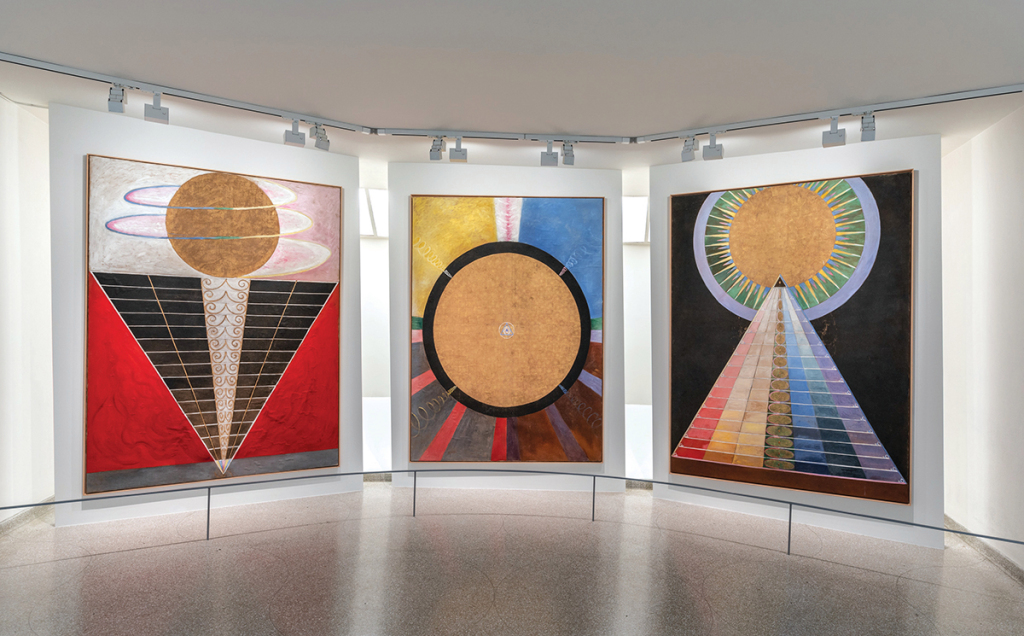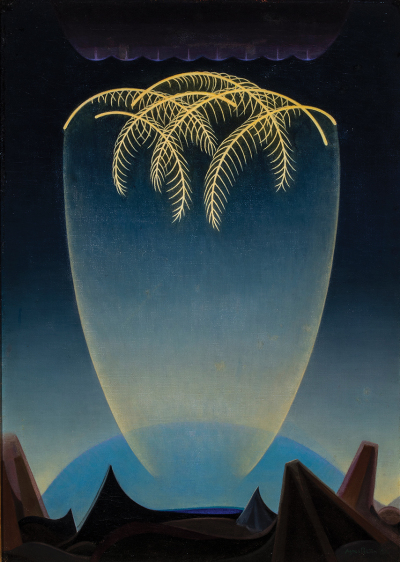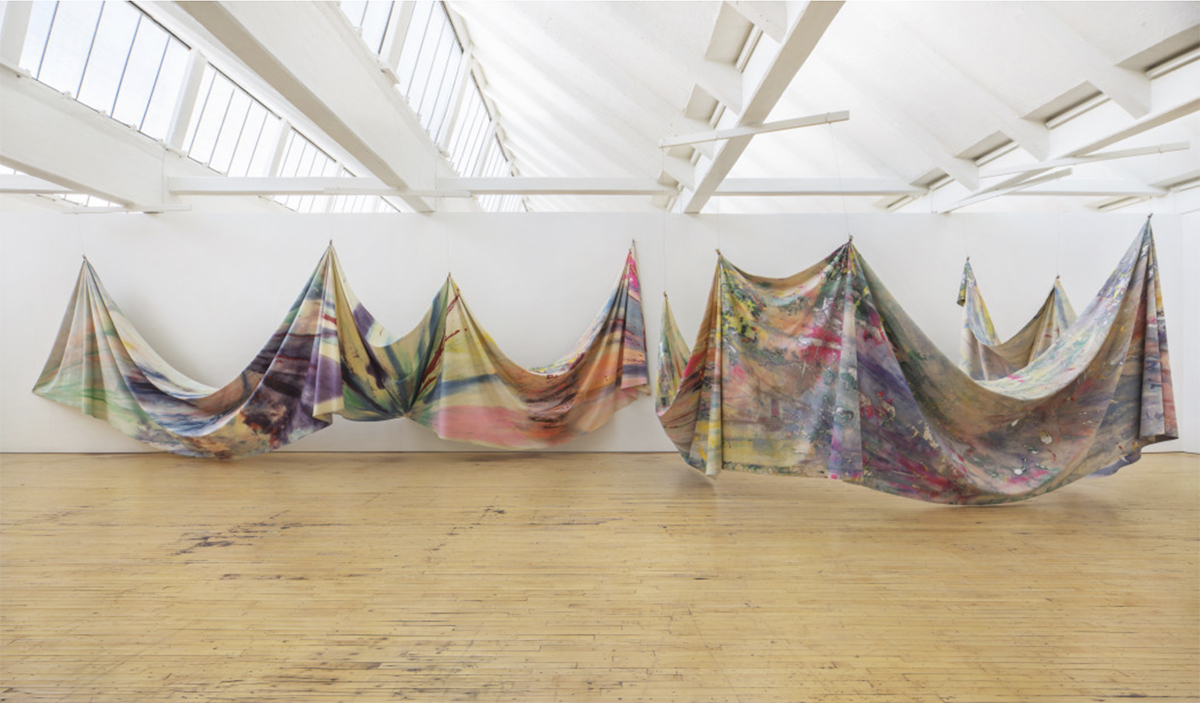 View of the exhibition “Hilma af Klint: Paintings for the Future,” 2018, at the Guggenheim Museum, New York. Photo David Heald/©2018 The Solomon R. Guggenheim Foundation
View of the exhibition “Hilma af Klint: Paintings for the Future,” 2018, at the Guggenheim Museum, New York. Photo David Heald/©2018 The Solomon R. Guggenheim Foundation
Being absorbed in visual abstraction has been, traditionally, a very good way to get some quiet. Whether besieged by a once again noisy culture, a relentlessly beckoning internet, or just our own yammering minds, there is plenty of reason to long for wordless, lumen-less art—for obstinately mute and immobile paintings and sculptures without namable content.
Alas, it is not to be. As is evident in a spate of recent exhibitions and publications, including modern and contemporary art scholar Pepe Karmel’s new book offering a global survey of the subject, abstraction has lately grown exceedingly jumpy. And voluble.
Conspicuous among its agitating energies is a revived spiritualism, headlined by the runaway fame of Hilma af Klint, whose 2018 exhibition at the Guggenheim Museum in New York shattered attendance records. According to many observers, it also smashed the long-established timeline for pure abstraction, pushing it back at least to 1907, when af Klint produced—under the guidance of otherworldly spirits, she said—whimsically majestic compositions that predated Malevich’s and Kandinsky’s abstract paintings of the following decade. Other early spirit-guided artists have been quickly dusted off, as in the well-received “Not Without My Ghosts: The Artist as Medium,” a 26-person exhibition that took place at the Drawing Room in London in 2020; notable among early, fully abstract contributions were Georgiana Houghton’s swirling effusions of the 1860s. The acclaimed survey “Agnes Pelton: Desert Transcendentalist,” which opened in 2019 at the Phoenix Art Museum before traveling to the Whitney Museum in New York the following year, presented a spiritually minded midcentury painter whose semi-abstractions glimmer spectrally with astral, floral, and landscape allusions.
While striking in its fervor, this big-tent revival is not the first of its kind. At the Drawing Center in New York in 2005, Catherine de Zegher organized “3 x Abstraction: New Methods of Drawing,” an exhibition linking, under the sign of nonsectarian faith, three linear abstractionists: af Klint, faith healer Emma Kunz, and Agnes Martin, also designated for the purpose a saint of the desert. Twenty years earlier, there had been the monumental “The Spiritual in Art: Abstract Painting 1890–1985,” organized by Maurice Tuchman for the Los Angeles County Museum of Art (and met with considerable skepticism at the time). Af Klint and Pelton are both featured in its massive catalogue, which ranges widely over what Tuchman, in the title of his keynote essay, calls “Hidden Meanings in The Spiritual in Art.” He admits at the outset that his effort to illuminate abstraction’s spiritual premises was hardly without precedent. And if the West Coast had long been especially hospitable to art that inclines toward transcendentalism—for instance, in the Light and Space installations of Robert Irwin and James Turrell—such leanings weren’t absent back East. The Dia Foundation, institutional seat of Minimalist materialism, also bears in its DNA the mystical Sufism practiced by its founders, Heiner Friedrich and Fariha al Jerrahi (née Philippa de Menil). Moreover, as Tuchman pointed out, the Theosophy that af Klint and Pelton practiced was shared by a host of early modernists, Mondrian and Kandinsky among them. The latest effervescence of such cosmic tendencies is, arguably, the mostly high-tech spectacles featured in the Pace gallery’s Superblue venture in Miami, which like Yayoi Kusama’s wildly popular mirror rooms, offer blissed-out, interactive immersive experiences—not altogether different in purpose from historic forms of sacred ritual—by artists ranging from Turrell, Mary Corse, and Nick Cave to Jacolby Satterwhite and teamLab.
If the current alliance of abstraction with nonsectarian spiritualism is nothing new, the question nonetheless arises of why it is now thriving. Perhaps it is a warning: civilizations in decline often turn toward mysticism, for instance, the Hellenistic mystery cults of the post-Classical Mediterranean. Or it may signify the bad odor now hanging over secular humanism. Seen by some as too European and too smug, secularism is at the center of a cultural crisis in France, where the nation’s vaunted, philosophically foundational laïcité is pitted against the reality of a growing Muslim population, supported by those on the left favoring recognition of the country’s plural identity, a situation complicated by an enduring Catholic (and anti-Semitic) heritage. Even in the US, it is clear that politically conservative white Christians have no patent on religious devotion: here, too, a turn against secular humanism has taken place on the left, while the religious right remains, naturally, allergic to it as well. But then, strange bedfellows in cultural politics are nothing new.
In any event, spiritualism is a leading but hardly exclusive element in the thoroughgoing reevaluation of abstract art, which has—with good reason, I believe—made it increasingly difficult to ignore a work’s time and place, motivation, reception, and, above all, its latent content, in which all these conditions are reflected.
 Agnes Pelton: Messengers, 1932, oil on canvas, 28 by 20 inches. Phoenix Art Museum
Agnes Pelton: Messengers, 1932, oil on canvas, 28 by 20 inches. Phoenix Art Museum
By way of a guide to this state of affairs there is Karmel’s big, beautiful, and wholly nonlinear volume Abstract Art: A Global History (Thames & Hudson, 2020). It is premised on the conviction, stated at the start, that “abstract art is always rooted in experience of the real world.” An af Klint painting appears on the cover and is discussed in the introduction to “Cosmologies,” one of the book’s five main chapters, each further subdivided into unabashedly incommensurable categories; paragraph-long discussions of individual works, illustrated at large size, follow the essays that head the various sections. Malevich is in the “Cosmologies” introduction too, cited for his interest in interplanetary travel, and so is Johannes Itten, the charismatic Bauhaus professor who brought esoteric rituals into the school’s foundation course. With less conceptual grounding, Jackson Pollock’s painting Reflection of the Big Dipper (1947) and David Smith’s sculpture Star Cage (1950) are both illustrated and glossed under the subdivision “Star Charts”; illustrated here as well are installations by Kusama and Felix Gonzalez-Torres. Despite opening this chapter with a consideration of Christian mysticism, Karmel is concerned not with questions of belief but, as throughout this study, with a taxonomy of forms. Brimming with scholarship and insight, his survey is a network of linked fragments, a rhizome, a Wunderkammer—in short, a book for our times.
Karmel’s definition of his subject is generous. “There is no either/or relationship between abstraction and figuration,” he writes, qualifying that judgment only slightly by excluding outright illusionism. Indeed, figures abound. The chapter “Bodies” (which begins with Picasso) is divided into “Dancers, Athletes and Poets”; “Workers and Machines” (here he observes, pungently, that “geometric abstraction was the artistic equivalent to Fordism”); “Embryos and Blobs”; “Totems”; “ Presences” (Alberto Giacometti and Louise Bourgeois); “Skins and Folds”; and “Organs and Fluids” (Kiki Smith, Lynda Benglis, Terry Winters, Carroll Dunham). There is a kind of cracked poetry to Karmel’s categories, which recall the passage from Borges that famously opens Michel Foucault’s The Order of Things; Borges describes an apocryphal encyclopedia in which animals are divided into a list that begins: “(a) belonging to the Emperor, (b) embalmed, (c) tame, (d) sucking pigs, (e) sirens, (f) fabulous, (g) stray dogs.” The thing we learn from “the exotic charm of [this] system of thought,” Foucault adds, “is the limitation of our own.” Clearly, it is a lesson still to be absorbed.
Karmel’s own intention, he writes, is to undermine the Hegelian notion of a progressive art history led by inner necessity and carried forward by heroic individuals. And while some such individuals are nonetheless wheeled onto the stage, they are allowed a measure of doubt. When Rothko declares, “I’m not an abstractionist,” but instead a painter “of basic human emotions: tragedy, ecstasy, doom, and so on,” it is the “and so on” that stands out to me, seeming to sheepishly temper his exorbitant, and now rather embarrassing, claims.
Apart from loosening the distinction between abstraction and other kinds of art by rooting it in social experience—David Reed is deemed a painter of “vortical landscapes,” who revives a Romantic motif to reflect “the abstract image of a world in perpetual motion” under the transforming effects of globalization; the flickering “vibratory field” seen in a painting by Roger Bissière is said to celebrate sheer survival, after the horrors of World War II—Abstract Art is dedicated to inclusivity. While old (or dead) white guys introduce most chapters, they’re followed by plenty of women and artists from all over. Karmel embraces the decorative arts, photography, and performance, as well as outliers of many kinds; he segues from Giacometti to Jasper Johns and Robert Morris, thence to dancer Simone Forti, and on to Michael Fried and his landmark essay on the theatricality of what came to be called Minimalism. One thing leads to another.
Karmel is not alone, of course, in looking to diversify the field. When the Museum of Modern Art in New York presented “Inventing Abstraction, 1910–1925” in 2012, the organizers were confident of the invention’s birthdate and place of origin (Europe, including western Russia): the emphasis on pure form was said to begin with Kandinsky, Delaunay, and Kupka. Since then, MoMA has made substantial efforts to mend its ways, for instance with its “Sur Moderno: Journeys of Abstraction” (2019), an overview of Latin American modernism.
In early 2020, New York University’s Grey Art Gallery presented “Taking Shape: Abstraction from the Arab World, 1950s–1980s.” One of the two shows inaugurating the Met Breuer in 2016 surveyed the career of Nasreen Mohamedi, a pioneering Indian abstractionist; later exhibitions there featured textile sculptures by Mrinalini Mukherjee; constructions by Jack Whitten, a once-neglected Black artist; and a survey of the Brazilian multidisciplinary abstractionist Lygia Pape.
The gender of abstraction, an implicit consideration in some of these shows, awaits its own survey. For many women, Minimalism’s formal austerity, with its staunch opposition to anything personal—narrative, touch, bodies, handcraft—confirmed that reductive abstraction was a man’s game. Condemning it in the 1974 essay, “An Autobiography of the Artist as an Autobiographer,” Eleanor Antin, a pioneering body artist and feminist, wrote, “An abstract painting is an alienated object whose value is determined by a complex set of cultural commitments remote from all human interest. In fact, one of the major components that goes into determining its art value is the degree of its remoteness.” In the 1960s and early ’70s, women abstractionists resisted this alienation with the use of textiles, ceramics, and other materials and processes associated with handcraft, and they favored the complexities of Pattern and Decoration, all now enjoying renewed attention. Even in its early years, Minimalism was sometimes seen as softened—hence feminized—by evidence of the artist’s hand at work. That is the case with the belatedly ascendant Agnes Martin, though she was no supporter of any links between her work and textiles, or women’s work, or for that matter, femininity itself.
By disposition and age, Martin, although romantically linked with women, was not inclined to endorse the queering of abstraction, either. But Carrie Moyer is. A painter whom Karmel categorizes under “Bodies” (subdivision, “Organs and Fluids”), Moyer asserted, in a recent online DC Moore Gallery conversation with figurative painter David Humphrey, that “modernism is still present. I’m still reacting to its don’ts, as a woman who is queer.” When Humphrey observed, “I feel your work has the voice of emphatic graphics, of public enunciation. It’s brassy,” Moyer readily agreed, linking those qualities to her early agitprop work for Dyke Action Machine! “I’m not interested in sharing a tender moment with the viewer,” she said. “It’s much more exclamatory than that.” But worrying that “everything is instrumentalized in our culture,” she wondered, “what does a painter do?”
 Sam Gilliam: Double Merge, 1968, acrylic on canvas; at Dia:Beacon, New York. Photo Bill Jacobson Studio/©Sam Gilliam/Artists Rights Society (ARS), New York
Sam Gilliam: Double Merge, 1968, acrylic on canvas; at Dia:Beacon, New York. Photo Bill Jacobson Studio/©Sam Gilliam/Artists Rights Society (ARS), New York
One answer for abstractionists (though not for painters) is provided by Theaster Gates, a leading proponent of hybridizing craft and social practice. A skilled ceramist, Gates makes his own imposing and very beautiful ceramic sculptures; he has also organized community-based ceramics workshops that generate marketable products. The role of the headlining artist is contested, or at least rendered uncertain, in such collaborative projects. The same can be said about the practices of af Klint and Houghton, if we accept that they were, in any sense, led by spirits of the departed. These notions also apply to early Surrealism’s reliance on what André Breton called “psychic automatism,” a maneuver for evading conscious reflection that similarly led to things like cursive linear abstractions liberated from discernible meaning.
If it’s not the thinking mind (or ghosts) at work, who or what is it? How artists have construed the subconscious over the past century and more is a big, deep question. Many artists, abstract and figurative ones alike, confirm that their hands operate independently of conscious deliberation; many also describe imagery that comes to them unbidden, in vivid inspiration or in dreams. And then we have more than fifty years of argument that all art is a vessel for the creative energy that flows through a culture—or, just as often, reflects its blockage. Art historian Christa Robbins aims, in her new book, Artist as Author (University of Chicago Press, 2021), to “return to artists some of the agency that the ‘death of the author’ has denied them.” Her penetrating analysis centers on mid-twentieth-century abstractionists of the New York School, diving deep into the closely argued definitions of individual “action” put forward principally by Harold Rosenberg, and diversely exemplified by Jack Tworkov, Helen Frankenthaler, Sam Gilliam, and others. But this is no bid for finding personal meaning in abstract painting. Robbins contends that the artistic action in question is a matter of placing oneself in the formal and intellectual forward march of modern art. The “author” she has in mind is not defined by internal, emotional experience; on the contrary, Robbins approvingly quotes Rosalind Krauss’s 1972 complaint against “the psychologizing whine of ‘Existentialist’ criticism.” In a concluding discussion of (once again) Agnes Martin, Robbins argues that the self-identified Abstract Expressionist exemplified her peers’ investment in a “practiced relation to self, which places an emphasis on authorship as a site of inquiry and exploration.” In other words, the meaning of Martin’s grids is in the practice of their making—a labor that involves a physical process but also the “habits of mind and body.”
As is clear from all the preceding, a final question arises about whose attribution of meaning counts, since artist, viewer. and critic seldom agree. Reviewing the New Museum’s recent exhibition “Grief and Grievance: Art and Mourning in America,” Peter Schjeldahl enthused in the New Yorker about the stormy brushwork, glowing color, and majestic scale of paintings by Julie Mehretu and Mark Bradford, who he said represent a “resurgence of American art’s modern breakthrough after six decades in abeyance.” By contrast, Holland Cotter, writing about the same show for the New York Times, drew attention to these paintings’ underlying political content: government surveillance maps of Black neighborhoods in Los Angeles issued after the 1965 Watts uprising, in Bradford’s case, and in Mehretu’s, a “half-hidden” image of the 2017 white supremacist rally in Charlottesville, Virginia. To many viewers (myself included), both of these buried images were completely invisible. But knowing about them does vivify, or at least complicate, the artists’ works.
This is where the exhibition’s catalogue (and other explanatory material) comes in, providing the kind of information offered in Karmel’s book. The dismissal of pure formalism—and of the academic language supporting it—has, clearly, made room for an avalanche of political thought, social and cultural history, and biographical detail that visual evidence alone doesn’t reveal. In “The Circle with a Whole in the Middle,” a 2020 essay on Gilliam, examples of whose unstretched canvases are now on long-term view at Dia Beacon, theorist Fred Moten alludes to Ornette Coleman’s rhythms, to the “unseen, stolen work” of Black women hanging clothes out to dry, and to Gilliam’s “tenting and billowing of tint.” But Moten also suggests, “If you don’t try to get anything out of [Gilliam’s work], you can be drawn in, too.” Citing literary scholar Saidiya Hartman, he writes that it induces “a rush of steady contemplation, the apposition of the unthought, which turns out to have been thinking all along.”
As neuroscientist and art enthusiast Eric Kandel explains, unthought thinking, which I’ll take to mean mental activity that doesn’t quite reach consciousness, is inescapably associative. In Reductionism in Art and Brain Science: Bridging the Two Cultures (Columbia University Press, 2016), his short book about reductive abstraction and visual perception, Kandel explains that the human visual system defaults to meaningful form—that, given the skimpiest information, it will find familiar things (faces in particular). The science notwithstanding, abstractionists have long insisted that we can and should override that default. But humans are social animals; we use art, even at its most simple and spare, to communicate. Abstract art allows us, perhaps, to refresh the system—to tune up the perceptual and cognitive faculties so we can see things more clearly, more actively. Just as important, it keeps us alert to metaphor and meaning. It seems time to say good riddance to the false comfort of abstraction divorced from the world. We are in it, and it’s in us.
Source link : https://www.artnews.com/art-in-america/features/post-spiritual-abstraction-pepe-karmel-1234601717












